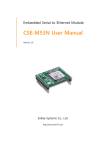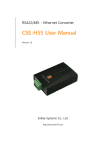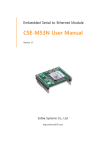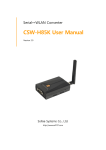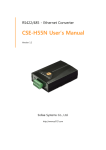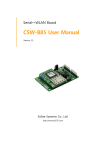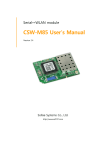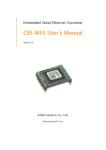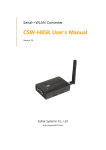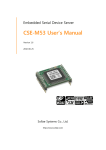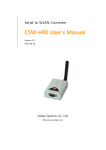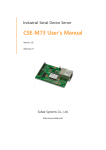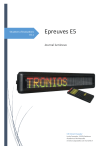Download CSE-H53N User`s Manual
Transcript
RS232 - Ethernet Converter CSE-H53N User’s Manual Version 1.2 Sollae Systems Co., Ltd. http://www.ezTCP.com CSE-H53N User’s Manual Ver. 1.2 This symbol, found on your product or on its packaging, indicates that this product should not be treated as household waste when you wish to dispose of it. Instead, it should be handed over to an applicable collection point for the recycling of electrical and electronic equipment. By ensuring this product is disposed of correctly, you will help prevent potential negative consequences to the environment and human health, which could otherwise be caused by inappropriate disposal of this product. The recycling of materials will help to conserve natural resources. For more detailed information about the recycling of this product, please contact your local city office, household waste disposal service or the retail store where you purchased this product. ※ This equipment obtained certification by using 1.5M serial cable. -1- http://www.ezTCP.com CSE-H53N User’s Manual Ver. 1.2 Contents 1 Overview ..................................................................................................................................- 5 - 1.1 Overview ................................................................................................................................................................ - 5 1.2 Main Features ...................................................................................................................................................... - 5 1.3 Application Examples ....................................................................................................................................... - 6 1.4 Components ......................................................................................................................................................... - 7 1.5 Specification ......................................................................................................................................................... - 8 - 1.5.1 Hardware ...................................................................................................................................................... - 8 1.5.2 Software ........................................................................................................................................................ - 8 1.6 Interfaces ............................................................................................................................................................... - 9 - 1.6.1 Serial Interface ........................................................................................................................................... - 9 1.6.2 Ethernet Interface .................................................................................................................................. - 11 1.6.3 Power ........................................................................................................................................................... - 12 1.7 System LED ........................................................................................................................................................ - 13 - 1.7.1 Function button ...................................................................................................................................... - 13 2 Installation and Test ............................................................................................................ - 14 - 2.1 Installation .......................................................................................................................................................... - 14 - 2.1.1 Setting Network Aera .......................................................................................................................... - 15 2.2 Simple Test ......................................................................................................................................................... - 17 3 Configuration ....................................................................................................................... - 20 - 3.1 Configuration with ezManager ................................................................................................................. - 20 - 3.1.1 Configuration via LAN ......................................................................................................................... - 20 3.1.2 Configuration via Serial ...................................................................................................................... - 21 3.2 AT command ..................................................................................................................................................... - 22 4 Operation Modes ................................................................................................................ - 23 - 4.1 What is the Operation Mode? .................................................................................................................. - 23 4.2 How to entering each mode ..................................................................................................................... - 23 4.3 Comparison of each mode ......................................................................................................................... - 24 4.4 Normal Mode ................................................................................................................................................... - 24 4.5 Serial Configuration Mode ......................................................................................................................... - 25 4.6 ISP Mode ............................................................................................................................................................ - 25 - 4.6.1 Upgrading Firmware............................................................................................................................. - 25 - -2- http://www.ezTCP.com CSE-H53N User’s Manual Ver. 1.2 4.6.2 Revoking Serurity Options................................................................................................................. - 25 5 Communication Modes ...................................................................................................... - 26 - 5.1 TCP Server .......................................................................................................................................................... - 26 - 5.1.1 Key parameters ....................................................................................................................................... - 26 5.1.2 Examples .................................................................................................................................................... - 27 5.2 TCP Client ........................................................................................................................................................... - 30 - 5.2.1 Key parameters ....................................................................................................................................... - 30 5.2.2 Examples .................................................................................................................................................... - 31 5.3 AT Command .................................................................................................................................................... - 34 - 5.3.1 Key parameters ....................................................................................................................................... - 34 5.3.2 Examples .................................................................................................................................................... - 35 5.4 UDP ....................................................................................................................................................................... - 38 - 5.4.1 Key parameters ....................................................................................................................................... - 38 5.4.2 Examples .................................................................................................................................................... - 39 6 System Management .......................................................................................................... - 41 - 6.1 Upgrading Firmware ...................................................................................................................................... - 41 - 6.1.1 Firmware .................................................................................................................................................... - 41 6.1.2 Processes ................................................................................................................................................... - 41 6.2 Status Monitoring ........................................................................................................................................... - 43 - 6.2.1 Using TELNET .......................................................................................................................................... - 43 6.2.2 Using ezManager ................................................................................................................................... - 45 6.3 Factory Reset ..................................................................................................................................................... - 49 - 6.3.1 Using Factory Reset .............................................................................................................................. - 49 6.3.2 Setting custom default values ......................................................................................................... - 50 7 Security Function ................................................................................................................. - 51 - 7.1 SSL ......................................................................................................................................................................... - 51 - 7.1.1 What is the SSL(Secure Socekt Layer)? ....................................................................................... - 51 7.1.2 How to set the SSL ............................................................................................................................... - 51 7.1.3 Restriction.................................................................................................................................................. - 52 7.2 Access Restriction (ezTCP Firewall) ......................................................................................................... - 53 - 7.2.1 Setting Password .................................................................................................................................... - 53 8 Additional Functions ........................................................................................................... - 54 - 8.1 Notify IPv4 Change ........................................................................................................................................ - 54 - -3- http://www.ezTCP.com CSE-H53N User’s Manual Ver. 1.2 8.2 Sending MAC Address.................................................................................................................................. - 55 8.3 Serial Port Tab Functions ............................................................................................................................. - 56 - 8.3.1 Disable TCP Transmission Delay - ① ........................................................................................... - 56 8.3.2 Separator - ②.......................................................................................................................................... - 56 8.3.3 TELNET COM port Control Option (RFC 2217) - ③.............................................................. - 57 8.3.4 TCP Server / Client mode - ④ ........................................................................................................ - 57 9 Checklist in Trouble............................................................................................................. - 58 - 9.1 Searching problem with ezManager ...................................................................................................... - 58 9.2 Connection Problem over TCP/IP ............................................................................................................ - 59 9.3 Data Communication Problem over the Serial Port ....................................................................... - 60 10 Related Material .................................................................................................................. - 61 - 10.1 Technical Documents .................................................................................................................................... - 61 10.2 Smart phone Application ............................................................................................................................ - 61 11 Technical Support and Warranty ...................................................................................... - 62 - 11.1 Technical Support ........................................................................................................................................... - 62 11.2 Warranty .............................................................................................................................................................. - 62 - 11.2.1 Refund ......................................................................................................................................................... - 62 11.2.2 Free Repair Services ............................................................................................................................. - 62 11.2.3 Charged Repair Services..................................................................................................................... - 62 12 Precaution and Exemption from Liability ....................................................................... - 63 - 12.1 Precaution........................................................................................................................................................... - 63 12.2 Exemption from Liability .............................................................................................................................. - 64 - 12.2.1 English version ........................................................................................................................................ - 64 12.2.2 French version ......................................................................................................................................... - 65 13 Revision History ................................................................................................................... - 67 - -4- http://www.ezTCP.com CSE-H53N User’s Manual Ver. 1.2 1 Overview 1.1 Overview Almost all communication devices including PC are using serial transmission. In this type, devices send and receive data in the order of each byte. The serial communication is quite simple to implement but has weaknesses like short distance and hard maintenance. CSE-H53N lets the serial devices connect to the Internet. To communicate on the Internet, devices should use TCP/IP protocol, so CSE-H53N processes the converting serial data to TCP/IP. 1.2 Main Features IPv4 / IPv6 dual stack Stateless / Stateful (DHCPv6) address auto-configuration RS232 (D-sub 9pin Male, speed up to 230.4Kbps) Industrial temperature range (-40℃ ~ +85℃) Variety of monitoring status (ezManager, TELNET) Security Protocols SSL3.0/TLS1.0 -5- http://www.ezTCP.com CSE-H53N User’s Manual Ver. 1.2 1.3 Application Examples 1:1 Connection with a PC Figure 1-1 1:1 connection with a PC Applied to LANs Figure 1-2 applied to LANs Applied to the Internet on Cable Networks Figure 1-3 applied to the Internet on cable networks -6- http://www.ezTCP.com CSE-H53N User’s Manual Ver. 1.2 Applied to the Internet with an IP Share Router Figure 1-4 applied to the Internet with an IP share router Applied to a serial tunneling system Figure 1-5 applied to a serial tunneling system Applied to a multi-drop network. 1.4 Components CSE-H53N’s Body CD, including utilities and documents (option) DC 5V Adapter (Option) RS232 cable (option) -7- http://www.ezTCP.com CSE-H53N User’s Manual Ver. 1.2 1.5 Specification 1.5.1 Hardware Power Input Voltage DC 5V (±10%) Current 120mA typical Dimension 89mm x 57mm x 24mm Weight About 65g Serial Serial Port RS232 (Baud Rate: 1,200bps ~ 230,400bps) 10 Base-T or 100 Base-TX Ethernet Auto-Sensing Network Auto MDI or MDIX cable Auto-Sensing Temperature Storage / Operating Temperature: -40 ~ 85℃ Approval KC, CE RoHS RoHS Compliant Table 1-1 Hardware specification 1.5.2 Software TCP, UDP, IPv4/IPv6 dual stack, , ICMPv6/TCPv6/UDPv6 Protocol ICMP, ARP, DHCP, PPPoE, DNS, DDNS(Dynamic DNS), Telnet, SSL, Telnet COM Port Control Option (RFC 2217) Normal For Normal Data Communication ISP For Upgrading F/W Serial Configuration For Configuration via Serial TCP Server TCP Passive Connection Communicat TCP Client TCP Active Connection ion mode AT Command TCP Passive / Active Connection UDP UDP Operation mode Major Utilities ezManager ezVSP Configuration Utility for MS Windows (Supports Downloading F/W) Serial to TCP/IP Virtual driver for MS Windows Table 1-2 Software specification -8- http://www.ezTCP.com CSE-H53N User’s Manual Ver. 1.2 1.6 Interfaces 1.6.1 Serial Interface CSE-H53N has a serial port for user serial device (1,200bps ~ 230,400bps). This port is interfaced with 9-pins D-sub Male connector. Figure 1-6 6 pins Terminal block Pin Assignment for RS232 Number Name Description level type Etc. 1 DCD Data Carrier Detect RS232 IN N/C 2 RXD Receive Data RS232 IN required 3 TXD Transmit Data RS232 OUT required 4 DTR Data Terminal Ready RS232 OUT optional 5 GND Ground Ground - required 6 DSR Data Set Ready RS232 IN optional 7 RTS Request To Send RS232 OUT optional 8 CTS Clear To Send RS232 IN optional 9 RI Ring Indicator RS232 IN N/C Table 1-3 pin assignment of the RS232 N/C : Not Connected -9- http://www.ezTCP.com CSE-H53N User’s Manual Ver. 1.2 Serial Port Parameters Parameter Value Number 1 Type RS232 Baud rate 1,200 ~ 230,400 [bps] Parity NONE / EVEN / ODD / MARK / SPACE Data bit 8/7 Stop bit 1 / 1.5 / 2 Flow control NONE, RTS/CTS, Xon/Xoff Table 1-4 serial port parameters - 10 - http://www.ezTCP.com CSE-H53N User’s Manual Ver. 1.2 1.6.2 Ethernet Interface Since part of CSE-H53N network is composed of Ethernet, UTP cable may be connected. It will automatically sense 10Mbits or 100Mbits Ethernet and connect itself. It also provides auto MDI/MDIX function that can automatically sense 1:1 cable or cross over cable. Figure 1-7 RJ45 the Ethernet connector interface RJ45 the Ethernet port interface Number Name Direction 1 TX+ Output 2 TX- Output 3 RX+ Input 4 - - 5 - - 6 RX- Input 7 - - 8 - - Table 1-5 RJ45 the Ethernet port interface Status of the system RJ45 LED Color LED status Blinks in every second Yellow Blinks 4 times at once Green Description Obtaining an IP address Without obtaining an IP address under DHCP or PPPoE network On Connecting with TCP On Connecting with Ethernet Off Not connecting with Ethernet. blinks Data is in network Table 1-6 LED status on the RJ45 LED - 11 - http://www.ezTCP.com CSE-H53N User’s Manual Ver. 1.2 1.6.3 Power DC 5V is used for the power. The specifications of the power jack are as the following: Figure 1-8 power jack - 12 - http://www.ezTCP.com CSE-H53N User’s Manual Ver. 1.2 1.7 System LED CSE-H53N has several lamps to show the current system status. Each lamp shows the following status: Mode Common Name Color Status Description PWR Red On Supplying the power LINK Green On Connecting with Ethernet RXD Yellow Blinks Receiving data from the Ethernet TXD Green Blinks Sending data to the Ethernet Blinks in every Normal mode ISP mode Serial Configuration mode Obtaining an IP address second STS Yellow Blinks 4 times Without obtaining an IP address at once under DHCP or PPPoE network On Connecting with TCP Off Entering ISP mode STS Yellow STS Yellow LINK Green Blinks RXD Yellow simultaneously TXD Green Entering Serial Configuration mode Table 1-7 LED status on the top panel 1.7.1 Function button There is a switch, which is named function switch (or button) located on the side of the product. You can change the operation mode of CSE-H53N to ISP or Serial Configuration mode with this switch. And it is used for factory reset. Figure 1-9 function switch - 13 - http://www.ezTCP.com CSE-H53N User’s Manual Ver. 1.2 2 Installation and Test 2.1 Installation Before testing CSE-H53N, users should connect both serial and Ethernet port to a PC. It will be no problem that the Ethernet connection includes network hubs. In case if your PC doesn’t have a RS232 port, use a USB to RS232 cable. Figure 2-1 connection between CSE-H53N and a PC - 14 - http://www.ezTCP.com CSE-H53N User’s Manual Ver. 1.2 2.1.1 Setting Network Aera This step is for setting both CSE-H53N and users’ PC to be located the same network. If only they are, the TCP connection between them can be established. Setting of the PC Add or change the IP address of the network adapter on your PC like following. Get into the menu of [Windows Control Panel] >> [Network Connections] >> [Properties of the Network Adapter – with right click of your mouse]. Then, you can show the properties of [Internet Protocol (TCP/IP). In there, press the [Advanced..] button for adding an IP Address like the below figure. Figure 2-2 adding / changing the IP address of users’ PC - 15 - http://www.ezTCP.com CSE-H53N User’s Manual Ver. 1.2 Setting of CSE-H53N CSE-H53N uses ezManager as it’s a configuration program. ezManager is for MS Windows, and this is comfortable to use because it doesn’t need installation. First, search your CSE-H53N via network. All the values of parameters are set the default values in the factory. To apply it to your system, proper values should be set via ezManager. Major parameters’ default values are listed on below table. To implement this simple test, keep these values without any changes. Name Network Option Serial Port (COM1) Default Values Local IP Address 10.1.0.1 Subnet Mask 255.0.0.0 IPv6 Disable TELNET Checked IP Address Search Checked Serial Type RS232 Baud Rate 19,200bps Parity NONE Data Bits 8 Stop Bit 1 Communication mode TCP Server Local Port 1470 Table 2-1 default values of Major parameters Refer to ezManager website for more details. - 16 - http://www.ezTCP.com CSE-H53N User’s Manual Ver. 1.2 2.2 Simple Test If you press the [Simple Test] button, test program will be shown on your screen. Connecting to the CSE-H53N via LAN Figure 2-3 settings for TCP connection ① Select [TCP Client] ② Input correct IP address and port number of CSE-H53N ③ Clink the [Connect] button. (In case of TCP Server, it will be [Listen] button) Opening RS232 Port Figure 2-4 opening COM Port ④ Select COM port which the CSE-H53N is connected to ⑤ Make sure that all the parameters are the same with CSE-H53N ⑥ Press the [Open] button - 17 - http://www.ezTCP.com CSE-H53N User’s Manual Ver. 1.2 Confirm the TCP Connection and COM port status Figure 2-5 TCP Connected message ⑦ Check the message if the TCP connection is established Figure 2-6 COM Port open message ⑧ Check the message if the COM port has been opened - 18 - http://www.ezTCP.com CSE-H53N User’s Manual Ver. 1.2 Data transmission test Figure 2-7 successful data transmission ⑨ Click the [Send data] on the LAN part ⑩ Check the data have been shown from the step ⑨ Figure 2-1 LAN → RS232 ⑪ Press the [Send data] on the RS232 part ⑫ Check the data have been received from the step ⑪ Figure 2-2 RS232 → LAN - 19 - http://www.ezTCP.com CSE-H53N User’s Manual Ver. 1.2 3 Configuration 3.1 Configuration with ezManager Figure 3-1 initial appearance of ezManager 3.1.1 Configuration via LAN Checklists Make sure the connection between your PC and CSE-H53N. If they are the same network, [MAC Address search] button can be used. If they aren’t, only [IP Address search] is allowed to use. Procedures Figure 3-2 procedures for configuration via LAN - 20 - http://www.ezTCP.com CSE-H53N User’s Manual Ver. 1.2 3.1.2 Configuration via Serial Checklists Make sure the connection between your PC and CSE-H53N using RS232 cross cable. To use this, CSE-H53N has to be operating in the [Serial Configuration] mode. Procedures Figure 3-3 procedures for configuration via Serial Step 2, Reading Figure 3-4 reading procedure via serial ① Choose the [Serial] tab ② Select the COM port which the CSE-H53N is connected with ③ Open the COM port with the [Open] button ④ Load the setting with [Read] button Refer to the [ezManager] manual on our website for details. You can download ezManager application for a smartphone on our website. - 21 - http://www.ezTCP.com CSE-H53N User’s Manual Ver. 1.2 3.2 AT command In the AT command mode, you can change some parameters through the serial port. Checklists Make sure the connection between your PC and CSE-H53N using RS232 cross cable. To use this, CSE-H53N has to be set to [AT command] mode as its communication mode. This can be configured by ezManager. Figure 3-5 setting the communication mode to the AT command Procedures Figure 3-6 procedures for configuration with AT command Division IP Address related items TCP connection related items Option Available parameters Local IP Address, DHCP, PPPoE, Subnet Mask, Gateway IP Address, DNS IP Address, ··· Local Port, Peer Address (IP Address or Host name), Peer Port, ··· ESC code sending option, timeout, ··· Table 3-1 parameters which are available to change with AT command Including above items, rest of parameters can be set by ezManager - 22 - http://www.ezTCP.com CSE-H53N User’s Manual Ver. 1.2 4 Operation Modes 4.1 What is the Operation Mode? Each of three operation mode of CSE-H53N is defined for specific purpose, and those are followed. Normal mode This mode is for normal data communication and has 4 different connection modes. Configuring parameters is also available in this mode. Serial configuration mode This mode is for configuring environmental parameters through the RS232 port. ISP mode This mode is for upgrading firmware. In addition, you can set environmental parameters even though the security options like password are activated by entering this mode. 4.2 How to entering each mode Figure 4-1 How to entering each mode ① Push the function button less than 1 second. ② Reset ③ Transfer a firmware by ezManager ④ Push the function button over than 1 second. - 23 - http://www.ezTCP.com CSE-H53N User’s Manual Ver. 1.2 4.3 Comparison of each mode Name Serial port Serial type Normal configured value RS232 Serial Configuration 115,200/N/8/1 RS232 ISP - - Table 4-1 comparison of each mode 4.4 Normal Mode In normal mode, there are four connection types to communication with a remote host. Mode Description TCP Server Wait connection request from TCP clients (Passive Connection) TCP Client Send connection request to a TCP server (Active Connection) AT Command UDP Control connections by AC commands (Active / Passive Connection) Communicate in block units without connection Table 4-2 comparison of communication mode Modifying Name Protocol Connection software of serial devices TCP Server TCP Client TCP AT Command UDP UDP Serial configuration Topology Passive - Unavailable 1:1 Active - Unavailable 1:1 Either Required Available 1:1 - - Unavailable N:M Table 4-3 comparison of four communication modes - 24 - http://www.ezTCP.com CSE-H53N User’s Manual Ver. 1.2 4.5 Serial Configuration Mode This mode is for setting environmental parameters through the serial port. ezManager has an interface for this mode. Use the [Read] button on the [Serial] tab. Refer to the [Serial Management Protocol] document on our website for details. 4.6 ISP Mode You can enter this mode by pressing the function button over 1 seconds. There are two special purposes in this mode. 4.6.1 Upgrading Firmware ISP mode is for upgrading firmware which is offered by us. The upgrade is implemented on Ethernet. The details are followed in the “6.1 Upgrading Firmware”. 4.6.2 Revoking Serurity Options CSE-H53N offers restriction methods for security like filtering password or MAC and IP address. In the ISP mode, you can revoke all of these. When you forgot the password, enter the ISP mode to solve the problem. - 25 - http://www.ezTCP.com CSE-H53N User’s Manual Ver. 1.2 5 Communication Modes 5.1 TCP Server In this mode, CSE-H53N listens to a TCP connection request from remote hosts. Once a host tries connecting to CSE-H53N, it accepts a connection. After the connection is established, CSE-H53N converts the raw data from the serial port to TCP/IP data and sends it to the network and vice versa. 5.1.1 Key parameters Local Port This is a server’s port number which is used in the TCP connection. Event Byte With setting event bytes, you can handle the serial data of the serial buffer before a TCP connection is established. Value 0 Otherwise (512 or under) Description CSE-H53N doesn’t send the data CSE-H53N sends the data right after a connection is established. 512 or under bytes are strongly recommended. Table 5-1 Event Byte Timeout If there is no transmission data for amount of the time the connection would be terminated. Notify IP Change This function is for notifying information about changed IP addresses to a management server. Not only can the TCP/UDP protocol be used, but Dynamic Domain Name Service (DDNS). Access restriction You can block TCP connections from unauthorized hosts by using this option. Both IP and MAC address are available. - 26 - http://www.ezTCP.com CSE-H53N User’s Manual Ver. 1.2 5.1.2 Examples A situation that [Event Byte] is set to 0. Figure 5-1 time chart Points States ~ CSE-H53N is listens to connection requests ① Remote host sends a connection request (SYN) segment ~ Processes of the connection ② The connection is established ~ Data communication is implemented on both side Table 5-2 states of each point Look at the blue arrow. The data “123” from the serial port has been sent before establishing a connection. In this case, the data would not be sent because of the [Event Byte] is set to 0. - 27 - http://www.ezTCP.com CSE-H53N User’s Manual Ver. 1.2 A situation that [Event Byte] is set to 1. Figure 5-2 time chart Points States ~ CSE-H53N listens connection requests ① Remote host sends a connection request (SYN) segment ~ Processes of the connection ② The connection is established ~ Data communication is implemented on both sides Table 5-3 states of each point As you can see, the data “123” has been sent right after establishing a connection because the value of [Event Byte] had been set to 1. - 28 - http://www.ezTCP.com CSE-H53N User’s Manual Ver. 1.2 A situation that [Timeout] is set to 5. Figure 5-3 time chart Points States ~ Data communication on both sides ① The last segment arrives at the CSE-H53N ~ No data communication for 5 seconds ② CSE-H53N send disconnection request (Fin) to a remote host ~ Processes of the disconnection ③ The connection is terminated ~ CSE-H53N listens connection requests Table 5-4 states of each point - 29 - http://www.ezTCP.com CSE-H53N User’s Manual Ver. 1.2 5.2 TCP Client In this mode, CSE-H53N sends request segments to a TCP server with information of [Peer Address] and [Peer Port]. Once a host is listening, the connection will be established. After then, CSE-H53N converts the raw data from the serial port to TCP/IP data and sends them to the network and vice versa. 5.2.1 Key parameters Peer Address This item is an address of TCP server Peer Port [Peer Port] is a port number of TCP server. Event Byte This item can decide the point of time to send the connection request parameter. Value 0 Otherwise (512 or under) Description Right after CSE-H53N boots up right after the bytes set to [Event Byte] have been received from the serial port Setting to less than 512 bytes is strongly recommended. Table 5-5 the operation of Event Byte 1 In addition, you can handle the serial data before a TCP connection is established with this parameter. Value 0 Otherwise (512 or under) Description CSE-H53N does not send the data CSE-H53N sends the data right after a connection is established. Setting to less than 512 bytes is strongly recommended. Table 5-6 the operation of Event Byte 2 Timeout If there is no data transmission for amount of the time the connection would be terminated. TCP Server This check option enables you to get to the TCP Server / Client mode. In this mode, CSE-H53N can be operated as a TCP server or client without changing its settings. - 30 - http://www.ezTCP.com CSE-H53N User’s Manual Ver. 1.2 DNS IP Address [DNS IP Address] needs when you use host name instead of the IP address. 5.2.2 Examples A situation that [Event Byte] is set to 0. Figure 5-4 time chart Points States ~ Power is not supplied yet. ① CSE-H53N sends a connection request segment right after it boots up ~ Processes of TCP connection ② The connection is established. ~ Data communication on both sides Table 5-7 state of each point Look at the blue arrow. The data “123” from the serial port was sent before establishing a connection. In this case, the data would not be sent because of the [Event Byte] is set to 0. - 31 - http://www.ezTCP.com CSE-H53N User’s Manual Ver. 1.2 A situation that [Event Byte] is set to 5. Figure 5-5 time chart Points ~ ① States CSE-H53N receives data from its serial port. CSE-H53N sends a connection request segment right after receiving 5 bytes. ~ Processes of the TCP connection ② The connection is established ~ The data “1234567” is transmitted to the remote host Table 5-8 states of each point As you can see, CSE-H53N has sent a request segment right after the size of the serial data has been 5 bytes. Even though they arrived before the connection, the data “123”, “45” and “67” was transmitted to the remote host because the [Event Byte] is set to 5. - 32 - http://www.ezTCP.com CSE-H53N User’s Manual Ver. 1.2 An activated [TCP Server] option Figure 5-6 time chart for activating [TCP Server] option Points States ~ CSE-H53N is listening to connection requests ① The connection has been established ~ CSE-H53N is on line and processes of the disconnection ② The connection has been terminated ~ Both sides are offline ③ Sends TCP connection request segment Table 5-9 state description The TCP Server / Client mode can be useful option by using [Event Byte] and [Timeout]. Note that only one TCP connection can be established at the same time, so users should consider setting [Timeout] properly. Refer to the [TCP server/Client mode] manual on our website for details. - 33 - http://www.ezTCP.com CSE-H53N User’s Manual Ver. 1.2 5.3 AT Command AT command is a mode which users control CSE-H53N with AT command like controlling modem. In this mode, active and passive TCP connections are available. And users are allowed to configure some environmental parameters with extended commands. 5.3.1 Key parameters The configuration should be implemented via the serial port of CSE-H53N Commands Description Examples +PLIP Local IP Address at+plip=10.1.0.1<CR> +PLP Local Port at+plp=1470<CR> +PRIP Peer IP Address at+prip=10.1.0.2<CR> +PRP Peer Port at+prp=1470<CR> +PDC DHCP at+pdc=1 (ON)<CR> +PPE PPPoE at+ppe=1 (ON)<CR> +PTO Timeout at+pto=10<CR> +PWP Store setting at+pwp<CR> Table 5-10 some of extended commands for configuration Related items with IP Address and Local Port Local port can be set as well as IP address related parameters like IP Address, Subnet Mask and Gateway IP Address. Peer Address / Peer Port IP address and local port of a remote host are can be set. Type of assigning IP address: Manual, DHCP, PPPoE Not only manual setting, also automatic assigning protocol (DHCP, PPPoE) are available. Others Some of options including [Timeout] can be configured in this mode. - 34 - http://www.ezTCP.com CSE-H53N User’s Manual Ver. 1.2 5.3.2 Examples TCP Server – setting parameters and passive connection Figure 5-7 time chart Points States ~ configuring parameters with AT commands ① ATA command has arrived. ~ CSE-H53N listens to TCP connection requests. ② A remote host sends SYN segment to CSE-H53N ~ Processes of TCP connection ③ TCP connection is established ~ CSE-H53N sends “CONNECT” message to the serial port Table 5-11 state of each other Refer to the [At Command(ATC) Mode] document on our website for details. - 35 - http://www.ezTCP.com CSE-H53N User’s Manual Ver. 1.2 TCP Client – setting parameters and active connection Figure 5-8 time chart Points ~ ① States configuring parameters with AT commands CSE-H53N sends a TCP connection request with the ATD command ~ Processes of TCP connection ② TCP connection is established ~ CSE-H53N sends “CONNECT” message to the serial port Table 5-12 state of each other - 36 - http://www.ezTCP.com CSE-H53N User’s Manual Ver. 1.2 Termination of online status – entering the AT command mode Figure 5-9 time chart Points ~ ① States TCP connection is on-line. The mode is changed to “command mode” after receiving “+++”. ~ command mode (TCP connection is off-line) ② CSE-H53N sends FIN segment right after the “ATH” arrives. ~ Processes of TCP disconnection ③ TCP connection is terminated ~ CSE-H53N sends “NO CARRIER” with disconnection Table 5-13 states of each other CSE-H53N changes the mode to AT command, when receiving “+++”. In this state, the communication with remote host is unavailable because CSE-H53N processes only AT commands. Whenever you want to go back to on-line state, just give “ATO” command. Refer to the [ATC mode] document on our website for details. - 37 - http://www.ezTCP.com CSE-H53N User’s Manual Ver. 1.2 5.4 UDP UDP has no connection processes. In this mode, data is sent in block units. Therefore, data that comes through CSE-H53N’s serial port is collected in block units to send it elsewhere. 5.4.1 Key parameters Block Size(Byte) [Block Size(Byte)] is to set the time to gather data in one block. Its unit is byte. If the data in configured size of the [Event Byte] comes into the serial port, CSE-H53N will send them as one block to the network. The maximum value could be 1460 bytes. Dynamic update of Peer host If you set the value of [Peer Address] and [Peer Port] to 0, [dynamic update of peer host] function is activated. By using this function, CSE-H53N can communicate to multiple hosts without additional setting. - 38 - http://www.ezTCP.com CSE-H53N User’s Manual Ver. 1.2 5.4.2 Examples Block Size: 5 bytes Figure 5-10 time chart Points ~ ① States CSE-H53N receives data from the serial port CSE-H53N sends 5 bytes as one block based on the [Event byte]. ~ Serial device sends data “678”. ② The data “678” arrives. ~ ③ ~ CSE-H53N sends data from the remote host to the serial device 2byte time has passed CSE-H53N sends data “678” as one block based on the [Data frame]. Table 5-14 state of each point - 39 - http://www.ezTCP.com CSE-H53N User’s Manual Ver. 1.2 Dynamic Update of Peer host This is a function that CSE-H53N automatically sets its peer host with information of the last packet received from network. The source address of the packet is set to the peer host. Parameters Values Peer Address 0 (None) Peer Port 0 Table 5-15 setting for [dynamic update of peer host] function Figure 5-11 time chart Points States ~ Sending any UDP data to the network is impossible. ① UDP data arrives from Remote Host 2. ~ Send UDP data to Remote Host 2. ② UDP data arrives from Remote Host 1. ~ Send UDP data to Remote Host 1. ③ UDP data arrives from Remote Host 2. ~ Send UDP data to Remote Host 2. Table 5-16 state description The data “ABC”, “DE”, “FGH” are from the serial port of CSE-H53N in the Figure 5-11. - 40 - http://www.ezTCP.com CSE-H53N User’s Manual Ver. 1.2 6 System Management 6.1 Upgrading Firmware 6.1.1 Firmware Firmware is a type of software for operation of CSE-H53N. If there are needs for adding function or fixing bugs, the firmware is modified and released. We recommend that users keep use the latest released firmware. 6.1.2 Processes Downloading the latest released firmware Download the newest firmware file. We update our homepage when a new firmware is released. You can find it on our website. Entering ISP mode Enter ISP mode to download firmware file to CSE-H53N. Run a TFTP client and ready to send the F/W file Run a TFTP client program. ezManager is equipped the client program. Click the [Change F/W / HTML] button. Figure 6-1 running TFTP client ① Check the [Advanced Menu] check box ② Click the [Change F/W / HTML] button to run TFTP client ③ Select the [Change Firmware] radio button ④ Input the IP address of CSE-H53N to the [Local IP Address] text box ⑤ Press the [Open Firmware / HTML] button and choose the firmware file - 41 - http://www.ezTCP.com CSE-H53N User’s Manual Ver. 1.2 Checking firmware file and Sending Figure 6-2 sending firmware file ① Check if the name and path of the firmware file are correct ② Click the [Send] button ③ Confirm the completed message - 42 - http://www.ezTCP.com CSE-H53N User’s Manual Ver. 1.2 6.2 Status Monitoring 6.2.1 Using TELNET Once the [TELNET] option is activated, users can remotely log in to CSE-H53N. If a password is set, users should input the password. After then, messages from CSE-H53N appear like the below figure. Figure 6-3 log in to CSE-H53N on TELNET Followed commands let users check each state. Command st sc Option Description Usage net IPv4 Network Status lsh>st net net6 IPv6 Network Status lsh>st net6 sio Serial Port Status lsh>st sio uptime System Uptime lsh>st uptime [op1][op2] Session Control lsh>sc com1 close Table 6-1 Commands for checking states st net “st net” command displays present IPv4 network states of all sessions. Figure 6-4 “st net command” - 43 - http://www.ezTCP.com CSE-H53N User’s Manual Ver. 1.2 st net6 “st net6” command displays present IPv6 network states of all sessions. Figure 6-5 “st net6 command” st sio “st sio” command displays the number of bytes for the serial port. Figure 6-6 “st sio” command st uptime “st uptime” command shows amount of time since CSE-H53N boots up. Figure 6-7 “st uptime” command sc “sc” command is used when users close a session. [op1] means the name of session, and [op2] should be “close”. Figure 6-8 “sc” command In case of the “sc” command you should use only small letters. You can download TCP Client application for a smartphone on our website. - 44 - http://www.ezTCP.com CSE-H53N User’s Manual Ver. 1.2 6.2.2 Using ezManager Status of CSE-H53N can be monitored by [Status] button on ezManager. By using the [Refresh Every 1 Second] option in the status window, the status is automatically updated in every second Figure 6-9 status window of ezManager FIRMWARE VERSION The name of model name and the version of firmware are displayed here. SYSTEM UPTIME Amount of time is displayed since CSE-H53N boots up. IP4 NETWORK INFORMATION All information about related items with IPv4 Address is shown here. It works even if the IP address is assigned from DHCP or PPPoE. - 45 - http://www.ezTCP.com CSE-H53N User’s Manual Ver. 1.2 IP6 NETWORK INFORMATION All information about related items with IPv6 Address is shown here. It works even if the IP address is assigned from DHCP or PPPoE. TCP STATE TCP status of each port is shown this section. Message Description LISTEN listening TCP connection CLOSE TCP connection is closed SYN_SENT ESTABLISHED N/A Send “SYN” segment to make TCP connection When TCP connection is established In UDP mode Table 6-2 TCP STATE SERIAL STATUS Amount of data in every buffer is displayed. The unit is byte. Buffer Description sio_rx The number of data which is received from the COM port net_tx The number of data which is sent to the remote host net_rx The number of data which is received from the remote host sio_tx The number of data which is sent to the COM port Table 6-3 SERIAL STATUS - 46 - http://www.ezTCP.com CSE-H53N User’s Manual Ver. 1.2 ARP/ND CACHE TABLE This part shows ARP table on CSE-H53N. When TCP connection is established or UDP data communication is performed, the information of IP and MAC address is automatically stored in the ARP table. This information is held for 1 minute. When 50 seconds is passed, CSE-H53N starts broadcasting the ARP packet again. If there is no response until the time is 0, the information is removed. If there is response, the time is updated 60 seconds again. In IPv6 case, it shows ND cache list. User can check by the ND cache messages. The messages are as follows. Status Description This means the device is standing by after it sends the INCOMPLETE request message, Neighbor Solicitation, to MAC and link local address of an opponent in the initial communication. This means the device has information about the opponent REACHABLE after it sends Neighbor Solicitation, and receives Neighbor Advertisement. STALE The device will change into STALE state after some time later reaching REACHABLE. The device will change into DELAY state if there is no DELAY response to Neighbor Solicitation. In this case, CSE-H53N will not be able to communicate with the device. CSE-H53N will resend the request message to the device in PROBE DELAY state. CSE-H53N will keep sending Neighbor Solicitation until it replies. TCP/IP Connection In this section, the same information with TCP STATE is displayed with IP address and port number. A difference is that users can terminate TCP connection. When right click on a session, a small pop-up window is created. Password This text box is activated when CSE-H53N has a password. If users want to close TCP connection with right click of mouse on the session, this password has to be correctly filled. Refresh Every 1 Second. If this option is checked, ezManager send query in every second. - 47 - http://www.ezTCP.com CSE-H53N User’s Manual Ver. 1.2 IP address Conflict Detection By clicking this button, you can find devices which have the same IP address to yours on the network. Figure 6-10 Without IP address conflict detection Figure 6-11 IP address conflict detection - 48 - http://www.ezTCP.com CSE-H53N User’s Manual Ver. 1.2 6.3 Factory Reset It is a function physically initializes all the setting. You can save a setting to user-defined ENV region and use it as default values by the factory reset. However, if you do not use the region, Factory Reset uses a factory default by manufacturer as its default values. 6.3.1 Using Factory Reset ① Push the function button low 1 second ② Push the function button over 10 seconds LED status is as follow pictures. STS ON LINK ON RXD ON TXD, RXD, LINK, STS, PWR are ON ③ TXD, RXD, LINK, STS are blinks - 49 - http://www.ezTCP.com CSE-H53N User’s Manual Ver. 1.2 6.3.2 Setting custom default values ① Change the mode to Serial Configuration ② Save custom default values by ezManager or serial configuration commands ③ Input the command below b <SPACE> 3c5a <CR> ④ After step ③, current values in the SRAM is saved in user-defined ENV region and the values will be always used for Factory Reset. - 50 - http://www.ezTCP.com CSE-H53N User’s Manual Ver. 1.2 7 Security Function 7.1 SSL 7.1.1 What is the SSL(Secure Socekt Layer)? SSL is cryptographic protocol that provides secure communication on the Internet. The SSL works over TCP. 7.1.2 How to set the SSL To works for SSL, you have to set the SSL-related parameters as the following steps. Set the [SSL] check box in the ezManager. ① Check the [SSL] of the [Option] tab of the ezManager. Figure 7-1 Setting of Option ② After check the [Advanced Menu] of the ezManager , Click the [Certificate]. Figure 7-2 Create the certification ③ Choice the [Write self signed certificate] Figure 7-3 Create the RSA Key - 51 - http://www.ezTCP.com CSE-H53N User’s Manual Ver. 1.2 ④ Input the key length and information in [Self signed certificate] Figure 7-4 Input the information ⑤ Check a success message. Figure 7-5 Check of success message 7.1.3 Restriction If user set the SSL with the CSE-H53N, the other device have to set the SSL. Maximum baud rate of serial port is the 115,200bps. Cannot use SSL feature in IPv6. - 52 - http://www.ezTCP.com CSE-H53N User’s Manual Ver. 1.2 7.2 Access Restriction (ezTCP Firewall) On the [Option] tab of ezManager, you can set access restriction function with MAC and IP address. Allowed MAC Address If this option has a valid value, the device which has the MAC address is only permitted to access. Allowed IP Address This is for qualifying hosts with IP address or range of IP addresses. The range is defined by multiplying [IP address] and [Network Mask] in bit unit. Examples for IPv4 IP Address Network Mask Allowed IP Address Range 10.1.0.1 255.0.0.0 10.1.0.1 ∼ 10.255.255.254 10.1.0.1 255.255.255.0 10.1.0.1 ∼ 10.1.0.254 192.168.1.4 255.255.255.255 192.168.1.4 Table 7-1 examples of defining allowed IPv4 range Apply to ezManager [Apply to ezManager] is for applying above two restrictions to ezManager functions like [Search], [Read], [Write] and etc. Examples for IPv6 IPv6 Address Prefix Allowed IP Address Range 2001:DB8::100 64 2001:DB8::1 ~ 2001:DB8::FFFF:FFFF:FFFF:FFFF 2001:DB8::100 128 2001:DB8::100 Table 7-2 examples of defining allowed IPv6 range 7.2.1 Setting Password A password can be used for protecting CSE-H53N from TELNET login or changing environmental parameters by hosts which are not qualified. The maximum length is 8 bytes of Alphabet or number. When you want to revoke all of these restrictions, operate CSE-H53N as ISP mode. In the mode, all restrictions are removable and communication with ezManager is revoked. - 53 - http://www.ezTCP.com CSE-H53N User’s Manual Ver. 1.2 8 Additional Functions 8.1 Notify IPv4 Change CSE-H53N can be TCP server even though it assigned IP address automatically. Using [Notify IP Change] function, CSE-H53N sends its IP address with the host name to the designed server. There are 3 types- DDNS, TCP and UDP- for this service. Dynamic Domain Name Service (DDNS) CSE-H53N supports DDNS service offered by DynDNS. Therefore, you have to make an account and create host names on the website of DynDNS before you use. All about service usage of an account could be changed according to the policy of DynDNS. DynDNS website: http://dyn.com/dns/ Figure 8-1 setting DDNS ① Select the [DDNS(dyndns.org)] ② 40,320 is a fixed value ③ Input the ID of DDNS account ④ Input the password of the account ⑤ Input a host name which you create on your account TCP/UDP In case you have an own server and want to manage the information about changed IP addresses, you allowed used TCP/UDP for using this option. The [Data Type] can be ASCII or hexadecimal, and the [Interval] is available on configuration. Refer to the [IP Change Notification] document on our website for details. - 54 - http://www.ezTCP.com CSE-H53N User’s Manual Ver. 1.2 8.2 Sending MAC Address [Sending MAC Address] is a function that CSE-H53N sends its MAC address to the remote host right after the connection is established. By using this function, a server can identify multiple devices with the information. Figure 8-2 setting of Sending MAC Address function ① Move to the [Option] tab. ② Check the [Send MAC Address] option. You can use [Send MAC Address] and [SSL] at the same time. Refer to the [Sending MAC Address Function] document on our website for details. - 55 - http://www.ezTCP.com CSE-H53N User’s Manual Ver. 1.2 8.3 Serial Port Tab Functions Figure 8-3 setting of Serial port tab functions 8.3.1 Disable TCP Transmission Delay - ① If you use this option, CSE-H53N sends the data from the serial port to LAN as quickly as possible. 8.3.2 Separator - ② Using this function, you can control the length of network packets by specific characters. separator options Length select the length between 0 ~ 4 bytes Transmit Separators without additional bytes Operation Transmit Separators + 1 byte Transmit Separators + 2 bytes Table 8-1 separator - 56 - http://www.ezTCP.com CSE-H53N User’s Manual Ver. 1.2 8.3.3 TELNET COM port Control Option (RFC 2217) - ③ This option is for sending and receiving serial port states between two devices. Users can send and receive control signals like RTS/CTS when the states are changed. Refer to the [Telnet COM Port Control Option] document on our website for details. 8.3.4 TCP Server / Client mode - ④ This mode is available on TCP client mode only. In this mode, you do not need to change the mode for switching active or passive TCP connection. Note that the [Event Byte] option should be set to more than 1. Refer to the [TCP Server / Client mode] document on our website for details. CSE-H53N’s Data Frame interval is configured 2byte data interval. Before sending data from the serial port to LAN, CSE-H53N gathers data in the buffer. If there is no data during the time configured in the 2byte data interval, it will send data to the network. - 57 - http://www.ezTCP.com CSE-H53N User’s Manual Ver. 1.2 9 Checklist in Trouble When users are in trouble with CSE-H53N, make sure all the followed steps first. 9.1 Searching problem with ezManager Confirming types of configuration utility CSE-H53N can be configured by ezManager. Stopping Firewall operation Firewalls of personal computer or network block broadcast packets. Stop all the firewalls before searching CSE-H53N Most of vaccine programs have firewall functions so it can cause some trouble to search CSE-H53N. Stop these programs before the searching. Stable supply of the power Check if the power is supplied continually. If the power is constantly supplied, the PWR (Red) LED on the CSE-H53N’s body will be turned ON. Connection with the network Make sure that the network connection is fine including Ethernet cable. In this step, we recommend that users connect CSE-H53N with PC directly or in the same network hub. Checking options of restriction In case that restriction of access is activated, the communication with ezManager can be impossible. When users are in this situation, make CSE-H53N operate in ISP mode. - 58 - http://www.ezTCP.com CSE-H53N User’s Manual Ver. 1.2 9.2 Connection Problem over TCP/IP Checking parameters related with TCP/IP When CSE-H53N has a private network IP address, personal computer’s IP address has to be the same sub network. Check if the IP address and local port number are correct. In case of a fixed IP address, the subnet mask, gateway IP address and DNS IP address should be configured. TCP Server side TCP Client side Local IP Address, Local Port, Subnet Mask, Local IP Address, Peer Address, Peer Port, Subnet Gateway IP Address, DNS IP Address, DDNS Mask, Gateway IP Address, DNS IP Address, Table 9-1 major parameters related with TCP/IP PING Test Confirm the connection over the network by PING test. If the CSE-H53N doesn’t send any reply from the request, check the network environment. Firewall In case the networks which need strong security, the access may be denied by their firewall. Under this circumstance, users should ask the person in charge of their network to release ports which will be used. (Ex: TCP 1470, UDP 50005) Operation Mode TCP connection is not possible when CSE-H53N is operating in the ISP or Serial Configuration mode. Communication Mode To make TCP connection, both a server and client should exist. If there are only servers or clients, TCP connection can’t be established. ezTCP Firewall When users set the ezTCP firewall with MAC and IP address, any hosts can’t be reachable to it except for the hosts which have the allowed MAC and IP address. Inactivate the option or check the setting is correct. Checking the TCP status TCP is a protocol connected one to one without multiple connection function. Because of this, if a device is on TCP connection, other requests are denied. If users are in this situation, check the network status by connecting on TELNET or using ezManager. - 59 - http://www.ezTCP.com CSE-H53N User’s Manual Ver. 1.2 9.3 Data Communication Problem over the Serial Port Connection of Pins Check if the connection of each pin is right. Using cables, users choose the right type of cable which is suitable for the device. Figure 9-1 RS232 connection Setting parameters Check if all the serial port parameters like Baud Rate, Data bit, Stop bit and Parity are properly set. Contact us if you have any questions about above steps or our products. - 60 - http://www.ezTCP.com CSE-H53N User’s Manual Ver. 1.2 10 Related Material 10.1 Technical Documents You can find the technical documents at our website. DataSheet IP Change Notification(DDNS) Sending MAC Address function TCP Server/Client mode Telnet COM Port Control Option 10.2 Smart phone Application ezManager(IOS) ezManager(Android) TCP/IP Client(Android) - 61 - http://www.ezTCP.com CSE-H53N User’s Manual Ver. 1.2 11 Technical Support and Warranty 11.1 Technical Support If you have any question regarding operation of the product, visit Customer Support FAQ corner and the message board on Sollae Systems’ web site or send us an email at the following address: E-mail: [email protected] Website Address for Customer Support: http://www.eztcp.com/en/support/ 11.2 Warranty 11.2.1 Refund Upon the customer’s request to refund the product within two weeks after purchase, Sollae Systems will refund the product. 11.2.2 Free Repair Services For product failures occurring within 2 years after purchase, Sollae Systems provides free repair services or exchange the product. However, if the product failure is due to user’s fault, repair service fees will be charged or the product will be replaced at user’s expense. 11.2.3 Charged Repair Services For product failures occurring after the warranty period (2 years) or resulting from user’s fault, repair service fees will be charged and the product will be replaced at user ’s expense. - 62 - http://www.ezTCP.com CSE-H53N User’s Manual Ver. 1.2 12 Precaution and Exemption from Liability 12.1 Precaution Sollae Systems is not responsible for product failures occurring due to user ’s alternation of the product. Specifications of the product are subject to change without prior notice for performance improvement. Sollae Systems does not guarantee successful operation of the product if the product was used under conditions deviating from the product specifications. Reverse engineering of firmware and applications provided by Sollae Systems is prohibited. Use of firmware and applications provided by Sollae Systems for purposes other than those for which they were designed is prohibited. Do not use the product in an extremely cold or hot place or in a place where vibration is severe. Do not use the product in an environment in which humidity is high or a lot of oil exists. Do not use the product where there is caustic or combustible gas. Sollae Systems does not guarantee normal operation of the product under the conditions a lot of noise exists. Do not use the product for a purpose that requires exceptional quality and reliability relating to user’s injuries or accidents – aerospace, aviation, health care, nuclear power, transportation, and safety purposes. Sollae Systems is not responsible for any accident or damage occurring while using the product. - 63 - http://www.ezTCP.com CSE-H53N User’s Manual Ver. 1.2 12.2 Exemption from Liability 12.2.1 English version In no event shall Sollae Systems Co., Ltd. and its distributors be liable for any damages whatsoever (including, without limitation, damages for loss of profit, operating cost for commercial interruption, loss of information, or any other financial loss) from the use or inability to use the CSE-H53N even if Sollae Systems Co., Ltd. or its distributors have been informed of such damages. The CSE-H53N is not designed and not authorized for use in military applications, in nuclear applications, in airport applications or for use in applications involving explosives, or in medical applications, or for use in security alarm, or for use in a fire alarm, or in applications involving elevators, or in embedded applications in vehicles such as but not limited to cars, planes, trucks, boats, aircraft, helicopters, etc.. In the same way, the CSE-H53N is not designed, or intended, or authorized to test, develop, or be built into applications where failure could create a dangerous situation that may result in financial losses, damage to property, personal injury, or the death of people or animals. If you use the CSE-H53N voluntarily or involuntarily for such unauthorized applications, you agree to subtract Sollae Systems Co., Ltd. and its distributors from all liability for any claim for compensation. Sollae Systems Co., Ltd. and its distributors entire liability and your exclusive remedy shall be Sollae Systems Co., Ltd. and its distributors option for the return of the price paid for, or repair, or replacement of the CSE-H53N. Sollae Systems Co., Ltd. and its distributors disclaim all other warranties, either expressed or implied, including, but not limited to, the implied warranties of merchantability and fitness for a particular purpose, with respect to the CSE-H53N including accompanying written material, hardware and firmware. - 64 - http://www.ezTCP.com CSE-H53N User’s Manual Ver. 1.2 12.2.2 French version Documentation La documentation du boîtier CSE-H53N est conçue avec la plus grande attention. Tous les efforts ont été mis en œuvre pour éviter les anomalies. Toutefois, nous ne pouvons garantir que cette documentation soit à 100% exempt de toute erreur. Les informations présentes dans cette documentation sont données à titre indicatif. Les caractéristiques techniques peuvent changer à tout moment sans aucun préavis dans le but d'améliorer la qualité et les possibilités des produits. Copyright et appellations commerciales Toutes les marques, les procédés, les références et les appellations commerciales des produits cités dans la documentation appartiennent à leur propriétaire et Fabricant respectif. Conditions d’utilisations et limite de responsabilité En aucun cas Sollae Systems Co., Ltd ou un de ses distributeurs ne pourra être tenu responsable de dommages quels qu'ils soient (intégrant, mais sans limitation, les dommages pour perte de bénéfice commercial, interruption d'exploitation commerciale, perte d’informations et de données à caractère commercial ou de toute autre perte financière) provenant de l'utilisation ou de l'incapacité à pouvoir utiliser le boîtier CSEH53N, même si Sollae Systems Co., Ltd ou un de ses distributeurs a été informé de la possibilité de tels dommages. Le boîtier CSE-H53N est exclusivement prévu pour un usage en intérieur, dans un environnement sec, tempéré (+10 °C à +40°C) et non poussiéreux. Le boîtier CSE-H53N n’est pas prévu, ni autorisé pour être utilisé en extérieur, ni de façon embarquée dans des engins mobiles de quelque nature que ce soit (voiture, camion, train, avion, etc…), ni en milieu explosif, ni dans des enceintes nucléaires, ni dans des ascenseurs, ni dans des aéroports, ni dans des enceintes hospitaliers, ni pour des applications à caractère médical, ni dans des dispositifs de détection et d’alerte anti-intrusion, ni dans des dispositifs de détection et d’alerte anti-incendie, ni dans des dispositifs d’alarme GTC, ni pour des applications militaires. De même, le boîtier CSE-H53N n’est pas conçu, ni destiné, ni autorisé pour expérimenter, développer ou être intégré au sein d’applications dans lesquelles une défaillance de celui-ci pourrait créer une situation dangereuse pouvant entraîner des pertes financières, des - 65 - http://www.ezTCP.com CSE-H53N User’s Manual Ver. 1.2 dégâts matériel, des blessures corporelles ou la mort de personnes ou d’animaux. Si vous utilisez le boîtier CSE-H53N volontairement ou involontairement pour de telles applications non autorisées, vous vous engagez à soustraire Sollae Systems Co., Ltd et ses distributeurs de toute responsabilité et de toute demande de dédommagement. En cas de litige, l'entière responsabilité de Sollae Systems Co., Ltd et de ses distributeurs vis-à-vis de votre recours durant la période de garantie se limitera exclusivement selon le choix de Sollae Systems Co., Ltd et de ses distributeurs au remboursement de votre produit ou de sa réparation ou de son échange. Sollae Systems Co., Ltd et ses distributeurs démentent toutes autres garanties, exprimées ou implicites. Tous les boîtiers CSE-H53N sont testés avant expédition. Toute utilisation en dehors des spécifications et limites indiquées dans cette documentation ainsi que les court-circuit, les chocs, les utilisations non autorisées, pourront affecter la fiabilité, créer des dysfonctionnements et/ou la destruction du boîtier CSE-H53N sans que la responsabilité de Sollae Systems Co., Ltd et de ses distributeurs ne puissent être mise en cause, ni que le boîtier CSE-H53N puisse être échangé au titre de la garantie. Rappel sur l’évacuation des équipements électroniques usagés Le symbole de la poubelle barré présent sur le boîtier CSE-H53N indique que vous ne pouvez pas vous débarrasser de ce dernier de la même façon que vos déchets courants. Au contraire, vous êtes responsable de l’évacuation en fin de vie (ou qu’il est hors d’usage) et à cet effet, du boîtier CSE-H53N lorsqu’il arrive vous êtes tenu de le remettre à un point de collecte agréé pour le recyclage des équipements électriques et électroniques usagés. Le tri, l’évacuation et le recyclage séparés de vos équipements usagés permettent de préserver les ressources naturelles et de s’assurer que ces équipements sont recyclés dans le respect de la santé humaine et de l’environnement. Pour plus d’informations sur les lieux de collecte des équipements électroniques usagés, contacter votre mairie ou votre service local de traitement des déchets. - 66 - http://www.ezTCP.com CSE-H53N User’s Manual Ver. 1.2 13 Revision History Date Version Comments Author 2012.11.22 1.0 ○ First version has been released. Lisa Shin 2013.05.08 1.1 ○ Delete descriptions of data frame option Lisa Shin ○ Add related material contents 2013.05.15 1.2 ○ Add Exemption from Liability contents - 67 - Lisa Shin http://www.ezTCP.com




































































